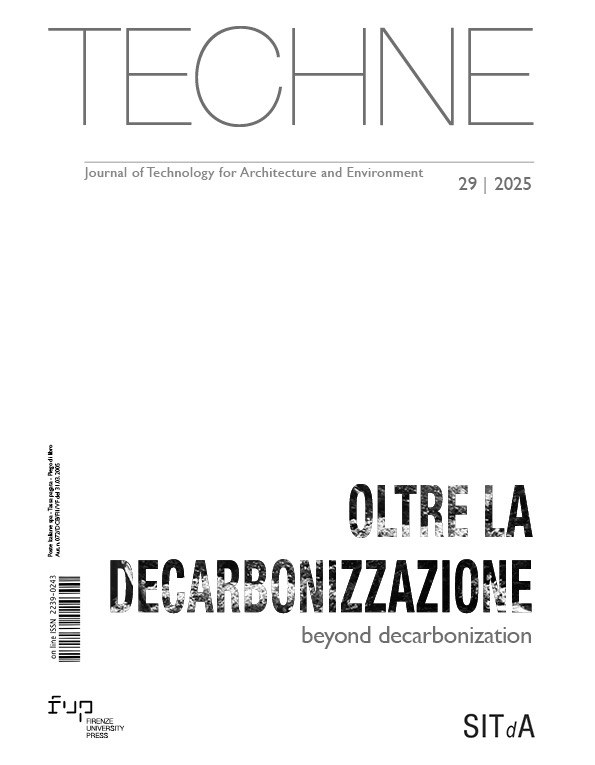Published 2025-07-31
Keywords
- Consumption carbon,
- Resource consumption,
- Inequity,
- Demand management,
- Stewardship
- Building stock ...More
How to Cite
Copyright (c) 2025 David Ness

This work is licensed under a Creative Commons Attribution 4.0 International License.
Abstract
Arguably, the 2015 papal encyclical letter Laudato Si’, on care for our common home, is particularly relevant nowadays as a way to combat rampant overconsumption and its impact on climate change and inequity – including within the building sector. Thus far, measures adopted by the sector to contain emissions have proved ineffective. Any gains via energy efficiency, ‘clean tech’ and renewables have been outpaced by growth in built floor area, which is projected to double by 2050. In addition to being a major theme of the encyclical, the concept of ‘sobriety’ (sufficiency) was introduced by the IPCC in 2022 as a way to achieve the necessary rapid and deep cuts in emissions. Involving practices and measures that avoid demand for resources while enabling well-being for all, the concept has only recently come to the fore. A milestone report on Sufficiency and the Built Environment was launched at COP29, with a potentially major impact upon architecture and building. While exploring these implications, the article examines the proposition that Laudato Si’ may inspire a sufficiency revolution embracing more innovative and holistic ways of tackling global challenges.
Downloads
References
- Allwood, J. (2014), “Squaring the circular economy: the role of recycling within a hierarchy of material management strategies”, in: Worrell, Ernst, and Reuter (Eds), Handbook of recycling, Elsevier, Amsterdam.
- ARUP (2022), Circular buildings toolkit, March.
- Barber, D.A. (2024), “Drawing the line”, Places Journal, January. Available at: https://doi.org/10.22269/240130 DOI: https://doi.org/10.22269/240130
- Brand, S. (1995), How buildings learn: what happens after they’re built? 1 October, Penguin.
- Creutzig, F., Niamir, L., Bai, X., et al. (2021), “Demand-side solutions to climate change mitigation consistent with high levels of well-being”, Nature Climate Change. Available at: https://doi.org/10.5281/zenodo.5163965
- EC (2020), A Renovation Wave for Europe – Greening Our Buildings, Creating Jobs, Improving Lives. European Commission.
- Francis (2015), Laudato Si’ Encyclical Letter on Care for Our Common Home.
- Georgescu-Roegen, N. (1973), “The entropy law and the economic problem”, in Daly, H. E. (Ed.), Toward a steady-state economy, Freeman, pp. 37-49.
- Global ABC (2024a), Sufficiency and the Built Environment: Reducing Demand for Land, Floor Area, Materials and Energy as the First Step Towards Sustainable Buildings, Global Alliance for Buildings and Construction, Paris, July. Available at: https://globalabc.org/resources/publications/sufficiency-and-built-environment
- Global ABC (2024b), Sufficiency in the Building Sector: Report Findings and Future Perspectives, Webinar, 19 November. Available at: https://globalabc.org/events/sufficiency-building-sector-report-findings-and-future-perspectives
- Global ABC (2022), 2022 Global Status Report for Buildings and Construction. Global Alliance for Buildings and Construction, UN Environment Programme.
- Habert, G., Röck, M., Steininger, K., Lupisek, A., Birgisdottir, H., Design, H., Chandrakumar, et al. (2020), “Carbon budgets for buildings – Harmonising temporal, spatial and sectoral dimensions”, in Buildings & Cities, Vol. 1, n. 1, pp. 429-452. Available at: https://doi.org/10.5334/bc.47 DOI: https://doi.org/10.5334/bc.47
- Himes, A. (2021), “Talk by A. Himes to TedX Seattle”, Carbon Leadership Forum. Available at: https://carbonleadershipforum.org/tedx-himes-climate-
- HM Treasury (2013), Infrastructure Carbon Review. London, November.
- Horup, L. H., Steinmann, J., Le Den, X., Röck, M., Sørensen, A., Tozan, B. and Birgisdottir, H. (2022), Towards EU embodied carbon benchmarks for buildings #3 Defining budget-based targets – A top-down approach. Available at: https://doi.org/10.5281/zenodo.6120882
- IEA (2023), The Buildings Breakthrough 2023, International Energy Agency.
- IPCC (2023), Summary for Policy Makers, AR6 Synthesis Report Climate Change 2023.
- IPCC (2022), Mitigation of Climate Change, AR6 Report Climate Change 2022.
- Kohler, N., and Hassler, U. (2002), “The building stock as a research object”, Building Research & Information, Vol. 30, n. 4 pp. 226-236. Available at: https://doi.org/10.1080/09613210110102238 DOI: https://doi.org/10.1080/09613210110102238
- Leoni, S. (2021), “The challenge of circularity in the construction sector”, TECHNE – Journal of Technology for Architecture and Environment, Vol. 22, pp. 22-27. Available at: https://doi.org/10.36253/techne-11536 DOI: https://doi.org/10.36253/techne-11536
- Lifschutz, A. (2017), “Designing buildings for change”, Architectural Design, Vol. 87, n. 5. DOI: https://doi.org/10.1002/ad.2209
- Longbottom, H. (2015) An overview of Laudato Si, The Jesuit Post, June 18. Available at: https://thejesuitpost.org/2015/06/an-overview-of-laudato-si/
- Ness, D. (2023), “Technological efficiency limitations to climate mitigation: why sufficiency is necessary”, Buildings and Cities, Vol. 4, n. 1, pp. 139-157. Available at: https://doi.org/10.5334/bc.297 DOI: https://doi.org/10.5334/bc.297
- Oxfam (2023), Climate Equality – A planet for the 99%, November.
- Princen, T. (2003), “Principles for sustainability: from cooperation and efficiency to sufficiency”, Global Environmental Politics, Vol. 3, n. 1, pp. 33-50. Available at: https://doi.org/10.1162/152638003763336374. DOI: https://doi.org/10.1162/152638003763336374
- Rees, W. (2009), “The ecological crisis and self-delusion: implications for the building sector”, Building Research and Information, Vol. 37, n. 3, pp. 300-311. Available at: https://doi.org/10.1080/09613210902781470 DOI: https://doi.org/10.1080/09613210902781470
- RIBA (2020), RIBA Plan of Work Overview. Royal Institute of British Architects.
- Richmond, L. (2024), COP29: Sufficiency and the built environment: Using less, achieving more, Architecture 2030, November. Available at: https://www.architecture2030.org/cop29-sufficiency-and-the-built-environment-using-less-achieving-more/
- RICS (2024), Whole life Carbon Assessment in the Built Environment, Royal Institution of Chartered Surveyors, August.
- Saheb, Y. (2021), Sufficiency and Circularity: the Two Overlooked Decarbonisation Strategies in the ‘Fit for 55’ Package, European Environment Bureau, 7 October.
- UNEP (2020), Emissions Gap Report 2020, UN Environment Programme.
- Wainwright, O. (2021), Sometimes the answer is to do nothing, The Guardian.
- Walker, T. (2021), Does an emissions scandal await the real estate sector? 23 April, Schroders. Available at: https://www.schroders.com/en/insights/economics/does-an-emissions-scandal-await-the-real-estate-sector/
- Wiedenhofer, D., Haas, W. and Haberl, H. (2023), “Toward a sustainable circular economy on a full planet: the role of thermodynamic principles”, SSRN. Available at: http://dx.doi.org/10.2139/ssrn.4538296 DOI: https://doi.org/10.2139/ssrn.4538296
- Zuidema, R. (2015), Open building as the basis for circular economy, ETH Zurich.






